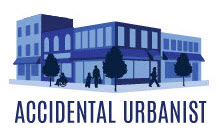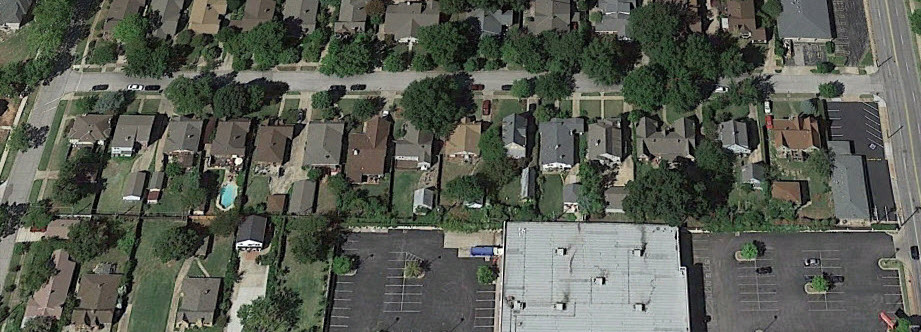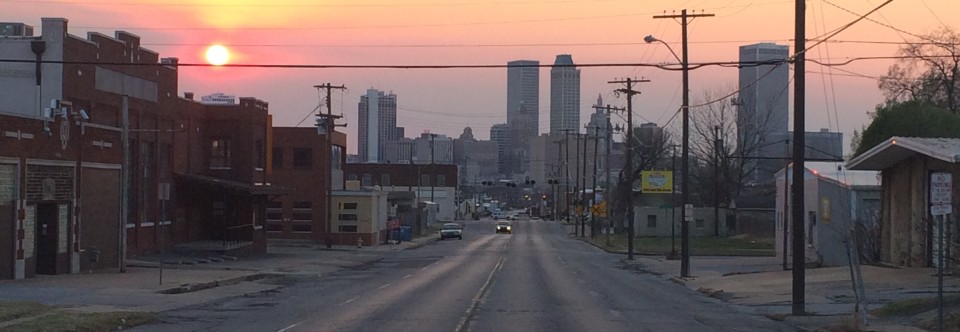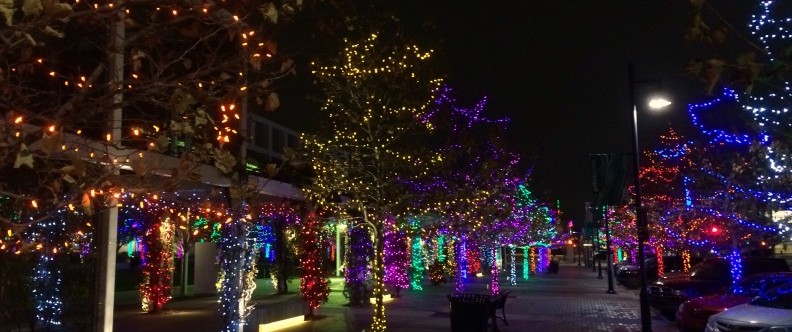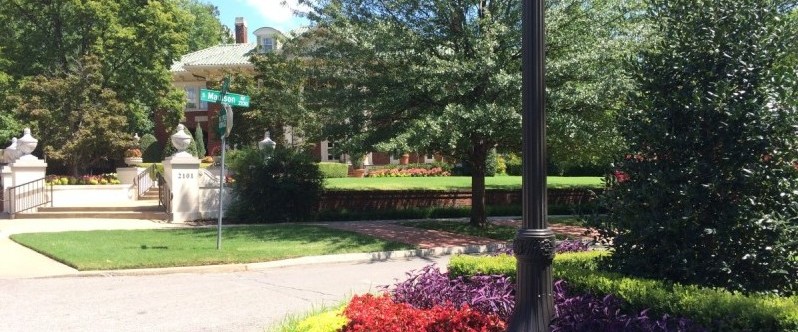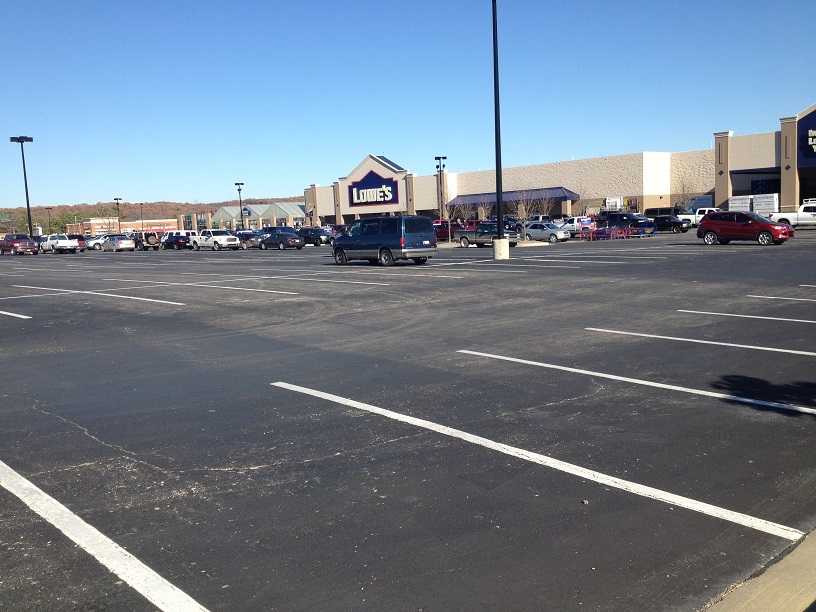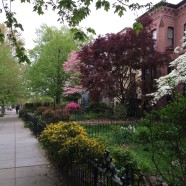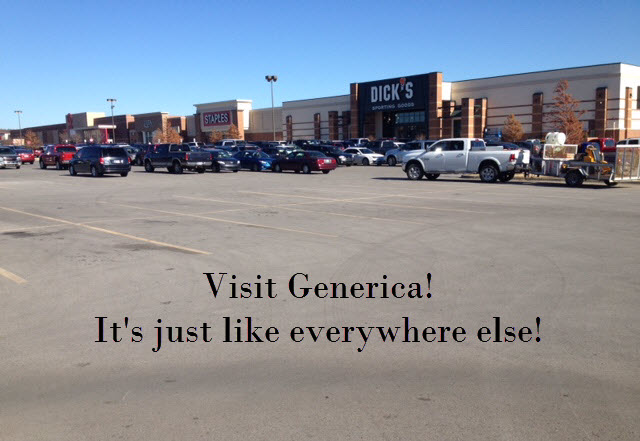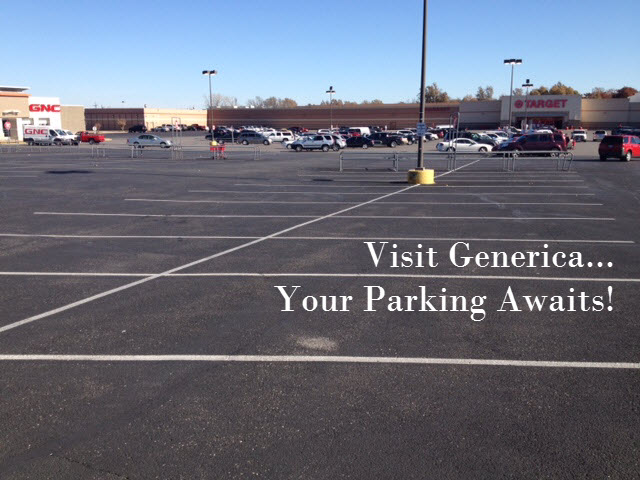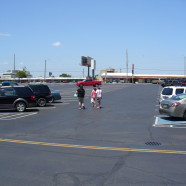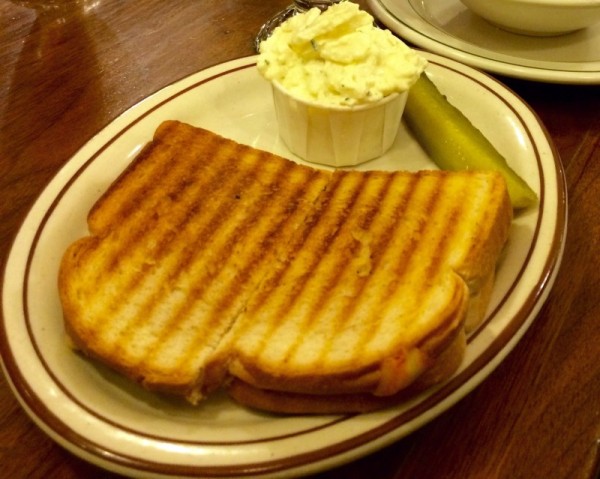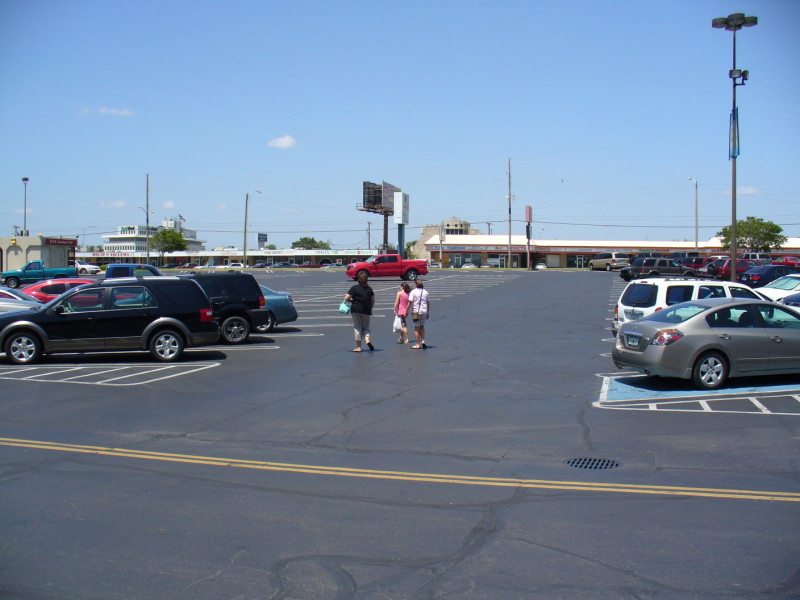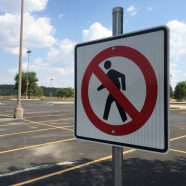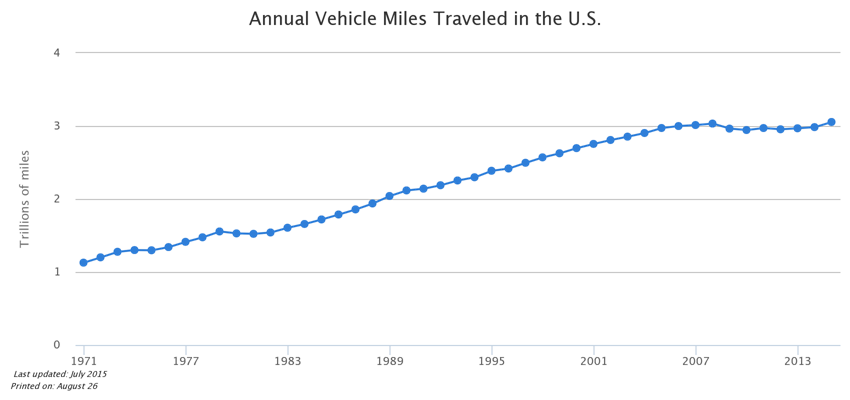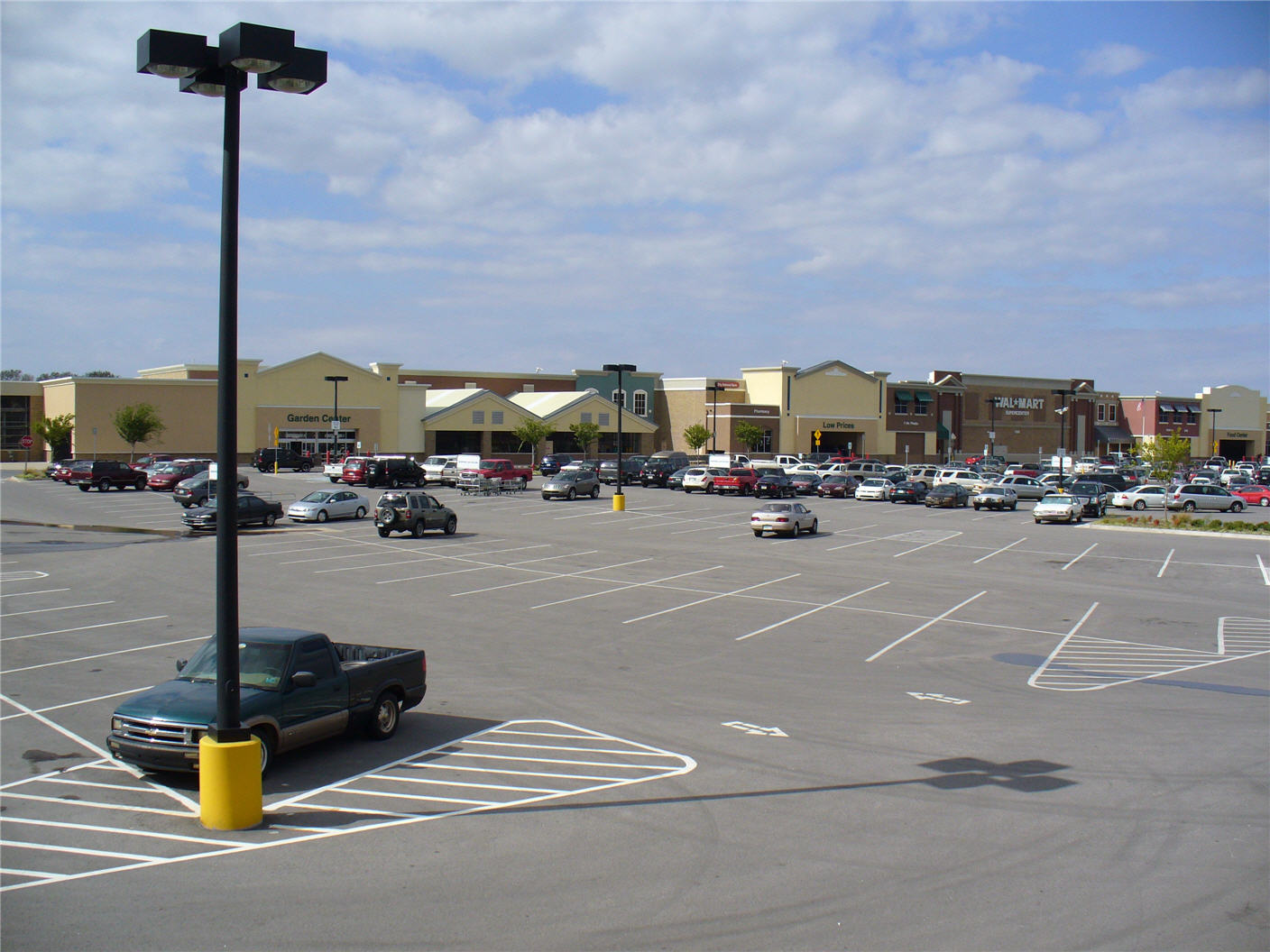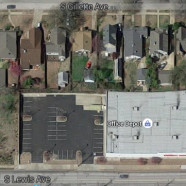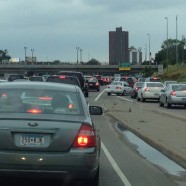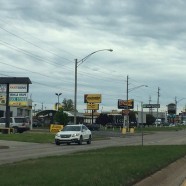So Many Shoppers, So Much Unused Parking
Back when I was a kid, we didn’t have Black Friday. We had after-Christmas specials. (At our house, the day after Thanksgiving was reserved for turkey tetrazzini and leftover pie.) The preferred shopping day for thrifty folks like my mom was the day after Christmas. A child of the Depression, she never met a 75% discount that she didn’t like. As a result, many of our Christmas gifts were purchased 364 days in advance, and squirrelled away until the following yuletide season.
I’m not sure exactly when the Black Friday craze began. Having never wrestled anyone to the ground for a Cabbage Patch Kid or fought to the death for a Gameboy, I’m pretty sure I missed out on the earliest incarnations of holiday shopping hysteria.
Even now, with all the media hype, I remain unconvinced that Black Friday actually exists.
We’re told that this is the “biggest shopping day of the year”—yet parking lots across the country tell a different story. Last year, I set out to explore #BlackFridayParking at commercial shopping centers across Tulsa to see for myself.
As I drove around town, the empty parking lots had me doubting Black Friday almost as much as I doubt the fat man in the red suit himself. Further research was needed. I was actually going to have to go shopping on Black Friday. (If you’re like me, the day you realize you can buy your favorite brand of underwear online is the day you celebrate never having to step inside a department store ever again. I really hate shopping.)
I headed to Tulsa Hills, one of our newest and most popular shopping centers, to check out the Black Friday madness. It was early afternoon and Dicks Sporting Goods was doing a brisk business, so—like Jane Goodall plunging into the Tanzanian jungle—I stepped through the automatic sliding glass doors to study Americans in their native habitat: the aisles of a big box store.
It was definitely crowded. The aisles were full of people browsing for everything from basketballs to badminton sets. Treadmills were being tested. Folks stood in line, arms loaded with yoga mats and sweatpants, waiting for cashiers. This was clearly no ordinary shopping day.
Visits to other stores yielded similar results. So yes, Virginia, there really is a Black Friday. But if this is truly the busiest shopping day of the year, why aren’t the parking lots full?
For years, we’ve been told that parking lots need to be large enough to accommodate peak parking demand. Sure, they’re not full on any given Tuesday, but we really need them on those big shopping days! (Or so the developers claim, as they tear down residential housing for commercial parking spaces that will never be used.)
On Black Friday, the Dick’s Sporting Goods store I visited had 155 empty parking spaces in their 261 space parking lot. This means that, on what is purported to be the busiest shopping day of the year, 62% of the available parking spaces were vacant.
Dick’s was not alone. Everywhere I went, I found oceans of empty asphalt, despite crowds of eager shoppers bustling inside the stores.
So what’s up with that?
My initial thought was to blame our local zoning ordinance for its high parking minimums. And while this is certainly a factor, it doesn’t appear to be the actual cause. As it turns out, national chains have their own development standards, which often far exceed local zoning requirements.
In Tulsa’s recently updated zoning code, parking requirements received a makeover. A retail store in a commercial shopping district is required to provide a minimum of 2.5 or 3.33 spaces per 1,000 SF of building. (The lower number is for CH and Mixed-Use zoning, which includes many of our older/historic “main streets.” In these areas, the first 5,000 SF of building space is exempt from parking requirements. Downtown has no parking requirements whatsoever.) While Donald Shoup would correctly argue that these requirements are both precise and wrong, they are a big improvement over our previous zoning code that required even more parking and treated every neighborhood like a 70’s suburb.
Here’s the rub. Many national retailers require around 5 parking spaces per 1,000 SF of building size. This is true of national chains as diverse as REI and PETCO, and it appears to be the case for Dick’s Sporting Goods, which has 261 parking spaces serving its 50,220 SF building.
Since every parking space takes up about 300 SF of land (once you factor in driveways and aisles), this means that every 50,000 SF of building area is accompanied by over 75,000 SF of asphalt.
And on Black Friday, when the parking lot at Dick’s was 60% vacant, it means that 46,500 SF of space—an area nearly as large as the store itself—sat empty.
That’s a lot of space to waste on the “busiest shopping day of the year.” But it’s nothing compared to a “normal” shopping day, which looks something like this:
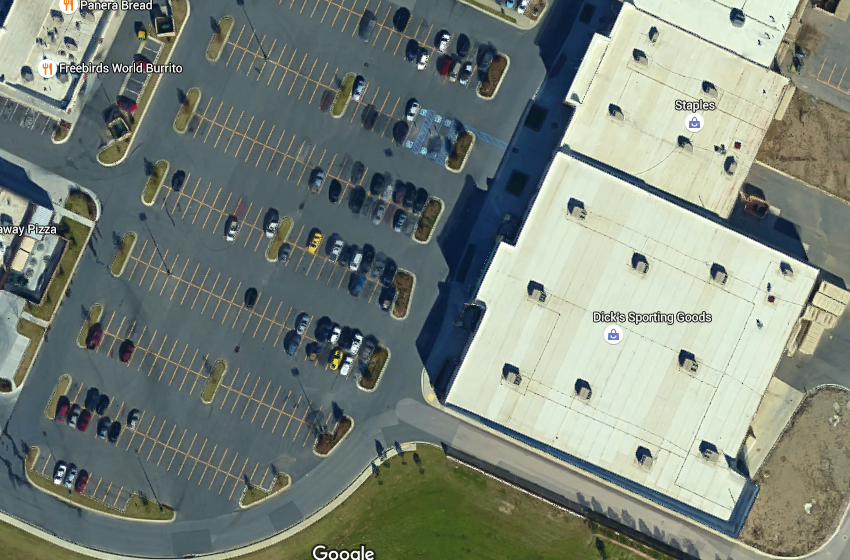
Why do I care? Because all that wasted space means we’re building and maintaining a lot more public infrastructure than we need. If you’ve been following the Strong Towns movement, it makes you think. When every destination is bloated by excessive parking, cities must provide and maintain additional miles of roadway, and manage more water, sewer and stormwater lines than they otherwise would. At the same time, we receive fewer tax dollars per acre of land within our city limits because of the poor use of space. It’s an inefficient system that hits municipalities–and taxpayers–directly in the pocketbook.
All this just because a bunch of national chains want twice as much parking as they need on the busiest shopping day of the year.
Maybe it’s time we started paying closer attention to the math.
By Sarah Kobos
Read MoreFungible or Great? What’s Your City’s Goal?
We all know what draws people to a place. Unique settings, historic districts, beautiful streets and parks. Places that cajole you and make you want get out of your car and explore. They can be invigorating and exciting, or beautiful and serene. Either way, they encourage discovery and leave you wanting more.
Inevitably, these are places of civic pride, proudly displayed on post cards and visitor’s bureau publications.
Unfortunately, our modern system of zoning often prevents us from building the very things that our visitor’s bureau would love to celebrate. Our zoning code ensures that we create great places for cars—but makes few allowances for the types of places that make communities proud.
Buildings must be set back far from the street. Every development must provide an absurd amount of parking. The width of driveway aisles and the size of parking spaces are immutable. Meanwhile, pedestrian amenities are optional afterthoughts. Oh, look! An awning. That’s adorable. Call the Visitor’s Bureau and tell them to bring a camera!
Over the course of decades, our zoning codes have created the perfect habitat for car-oriented national chains. And our reliance on sales tax makes city officials reluctant to demand something better from developers. Any proposal, no matter how generic or disposable, is greeted with enthusiastic approval when a municipality’s fate rests upon retail receipts.
Unfortunately, it’s hard to market your city, when all that growth adds nothing special to the place.
But what’s the long game?
Do we want to live in Generica? Do we really need all those national chains? Is our city’s goal to be redundant, offering only those things which can be found along any Interstate corridor in the nation?
Or do we want to create places of lasting quality that build long-term community wealth? Because if we want our city to be valued, we need to focus on what makes it unique and sets us apart.
It’s such an obvious fact, it’s amazing that we manage to ignore it every day.
Read MoreDoes That Parking Space Come with Fries?
Imagine living in a city where every restaurant is required by law to provide free chicken sandwiches. In addition to the free sandwiches, each restaurant offers a complete menu of items available for purchase. You can order roast beef or a reuben or an Albuquerque Turkey—but you have to pay for them.
The chicken sandwiches, however, are always free. And each day, restaurants must provide more than twice as many chicken sandwiches as their customers will eat. A majority of the sandwiches go to waste.
This would be absurd, right? What kind of communist plot would require a business to offer sandwiches for free?
Well, nearly every town in America does it. But they don’t require free sandwiches, they require something much more valuable: free parking.
But we need free parking…don’t we?
Even if they’re located next to a bus stop, or a bike route, or a residential neighborhood where their customers live, businesses across America must purchase extra land to build parking lots. Often, they must demolish existing buildings to do so. And while zoning ordinances don’t specifically require the parking to be free, we’ve built so much of the darn stuff, we’ve devalued it. People have come to expect free parking wherever they go. As a result, it’s a rare business that dares to charge for parking.
I’m sure you’re thinking: but we need all that parking! Everybody drives to the store!
It’s true, lots of folks drive. Why? Perhaps it’s time to revisit that town with the free sandwiches.
If chicken sandwiches are offered for free (while every other item on the menu costs money) what does that do to demand?
I think it’s fair to say that a lot more folks would eat chicken sandwiches in our imaginary town, even if they preferred pastrami on rye. Because a free sandwich is a free sandwich!
“A fertility drug for cars.”
In much the same way, when we require abundant off-street parking, but we don’t require infrastructure that supports transit, cycling or walking, we impact demand. Our zoning code essentially dictates that developments prioritize cars over people. So what do we get? A city full of cars.
As Donald Shoup famously wrote, “Minimum parking requirements act like a fertility drug for cars.”
And because we put the needs of cars before those of people, we require buildings to be set back far from the sidewalk. We require enormous parking lots located between the building and the street. We expect pedestrians and transit users to traverse asphalt wastelands and share space with speeding SUVs.
We make driving convenient and seemingly “free.” We make every other alternative inconvenient and unpleasant, and then we charge for transit. We are handing out the chicken sandwiches and wondering why so few people choose soup or salad.
But is all this parking actually “free?”
(The true cost of car ownership is a topic for another day, so let’s just focus on parking.)
Back to our imaginary town…
To offset the cost of free chicken sandwiches, restaurants would need to increase the price of every other item on the menu. Drinks, soups, salads, burgers—every other item would cost more because the chicken sandwiches were free.
It’s the same with parking: we all pay for it–whether we drive or not.
We pay because the price of goods and services includes the cost of all that free parking.
Gratuity included. Hidden fees may apply.
As communities, we pay because abundant parking makes land less productive. More asphalt means fewer businesses, fewer jobs, and fewer tax dollars per acre.
In addition, our tax dollars are spent to build and maintain roads so all those cars can travel from one “free” parking space to another. And the more parking you require, the further everyone must drive. Businesses and destinations are separated by great distances because of the space needed for parking.
Spreading out these destinations means that our tax dollars must fund additional miles of roadway. We also must provide and maintain more water, sewer, and stormwater pipe; more pumping stations; more fire stations; more police officers…. You get the idea.
It’s an inefficient system, and it needs to stop.
Since 1963, the population of the City of Tulsa has increased by about 30%. In this time, our city’s geographic area has expanded by approximately 300%. Most of this growth has come in the form of low-density, inefficient, suburban sprawl.
Thanks to parking minimums, approximately 2/3 of our commercial space is covered in asphalt. The remaining 1/3 of the commercial land cannot possibly generate all the taxes, jobs and commerce needed to support our city’s needs. We have built a lot of infrastructure for so few taxpayers.
And it makes for an awfully expensive free sandwich.
Read MoreUnhealthy by Design
For the first time in our history, we are raising a generation of kids who will have a shorter lifespan than their parents.
Take a moment and let that sink in.
It’s a startling fact.
Historically, the challenge for public health officials was the fight against infectious diseases. In 1900, the leading causes of death included pneumonia, tuberculosis, and some nasty intestinal maladies I’d rather not get into. (No need to gross everyone out.) Let’s just say that no amount of Pepto Bismol was going to help.
Happily, we spent the 20th century developing solutions to these problems. We created clean water and sanitary sewer systems. We developed antibiotics and immunizations. We learned about the importance of proper ventilation, hygiene and sanitation practices. Combined with increased worker and consumer safety regulations, these changes added 25 years to the average American’s lifespan.
Today that lifespan is decreasing. And now we have a totally different public health crisis: chronic diseases linked to inactivity and obesity.
In 2014, the leading causes of death were heart disease, cancer, lower respiratory disease, and stroke. Although diabetes is 7th on the list, the number of people with diabetes has tripled since 1994 with no end in sight. It’s estimated that by 2030—if trends don’t improve—more than 80% of Americans will be overweight or obese.
The Evolution of Inactivity
So what changed? Why, despite advances in drugs and medical procedures, are people less healthy today than 20 years ago? Why, despite all our focus on diet and healthy eating, are we gaining weight?
One major factor is the amount of physical activity we get.
Since 1994, the number of Americans reporting absolutely NO physical activity has increased from 17% to 52%.
Which just happens to be directly related to the amount of time Americans spend sitting in their cars.
Since 1980 the number of vehicle miles traveled has doubled.
If you look at the way we design our cities it’s no wonder. We’ve spent the past several decades prioritizing the needs of cars over the needs of people. We’ve designed inactivity and auto-dependence into our daily lives.
Convenient for Cars; Deadly for Humans
Instead of wide, tree-lined sidewalks and bike lanes, we get multi-lane roads designed for high-speed travel by automobiles. Instead of corner cafes and coffee shops, we get drive-thrus in the middle of asphalt oceans. Instead of buildings lining our main streets, we get businesses that are pushed back behind an obscene display of surface parking. Instead of homes on modest sized lots with connected street grids, we have giant yards on cul-de-sacs. And instead of building housing near schools, shopping and jobs, we separate each use—as if in fear of cross-contamination.
Our cities have been evolving to meet the needs of automobiles for over 50 years. Unfortunately, our bodies have evolved over a much longer period for a different purpose.
The human body is designed for action. We’re built to walk. We’re meant to be active. And while we’ve become more and more sedentary in recent decades, our inactivity comes at a cost.
If you need hard facts, try this one on for size. According to the American Diabetes Association, the cost of diabetes (direct medical costs and reduced productivity) has risen from $174 billion in 2007 to $245 billion in 2013, a 41% increase in just five years.
The Human Habitat
If we want to change our habits, we’re going to have to change the way we design our human habitats.
We’re going to have to start building places that are great for walking, biking and transit. We’re going to have to put the needs of people above the needs of automobiles.
The Urban Land Institute has put together a toolkit for “Building Healthy Places.” It includes a list of common sense solutions to help make our cities and towns healthier places to live. These include old-fashioned ideas like:
- Incorporate a mixture of land uses (don’t separate everything from everything else)
- Design well-connected street networks at the human scale (make it easy to get from place to place without a car)
- Provide sidewalks and enticing, pedestrian-oriented streetscapes (don’t punish people for walking)
- Provide infrastructure to support biking (burn calories, not gas)
It’s a great place to start the conversation. Other resources include The Center for Active Design and 8-80 Cities.org.
Americans need to get active. The beautiful thing about thoughtful urban design is that the activity is baked into your day. You don’t need a gym membership if you can bike to work or walk to dinner.
Now that’s food for thought.
Read MoreBell Bottoms, 8-Track Players, Parking Minimums…
Zoning is a funny thing. It’s the invisible hand that sculpts our cities. It’s the rulebook that governs private development—dictating what and where and how things are built. All too often, it’s the arrogant czar who proclaims “Nyet!” when a developer wants to build a place for people and pedestrians. Simply put, zoning has the power to make or break a place. But the topic is so boring, nobody wants to think about it.
Yet zoning—that dry, humorless, sleep-inducing code—is essential to the health of a city and the people who call it home.
If you’ve ever wondered why you can’t walk to the places you need to go, why parking lots have become the dominant architectural feature of our cities, or why there isn’t a coffee shop or a bakery in your neighborhood—congratulations! You’ve just discovered zoning!
Hopefully, Change Is on the Way
Tulsa is currently performing a comprehensive update of its zoning code for the first time since 1970. Like bell-bottom pants, pet rocks, and 8-track tape players, our zoning code should have been shelved decades ago. Instead it’s been dutifully chugging along: prioritizing automobile travel over every other option, punishing pedestrians and transit users, and turning our city into a giant parking lot.
Hopefully, change is on the way.
If you’re happy with the status quo, let’s see if a quick example can change your mind.
Take a look at the Office Depot at the corner of 15th and Lewis, which was built in 2004 on the site of an old grocery store.
In the current zoning code, this is considered “Shopping Goods and Services,” and the super-scientific-sounding code calls for 1 parking space per 225 square feet of building. Since the Office Depot building occupies 22,264 square feet, our zoning code (perhaps imagining a desperate run on staplers and toner cartridges) requires 99 parking spaces.
Here’s what that looks like:
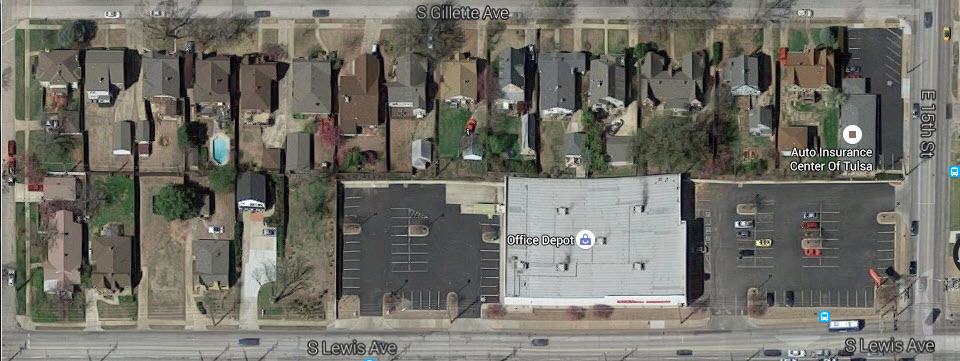
Although the building appears to front Lewis Avenue, it actually “faces” 15th Street (with a deep setback and parking in front). The front parking lot (to the right of the building) provides for 57 spaces, while the rear parking lot (shown to the left) contains 38. (Presumably, the developer received a variance to provide 95 spaces, instead of the 99 dictated by the zoning code.)
Important note: No one in the history of parking has ever actually parked behind this store.
In the proposed update to the zoning code, this location in the historic Gillette neighborhood would be considered “urban” and would receive a reduction in the amount of required parking. The proposed zoning code would require 1 space / 300 SF of building, equaling 74 required parking spaces.
The amount of land that could have been saved by the proposed new code is shown in red below.
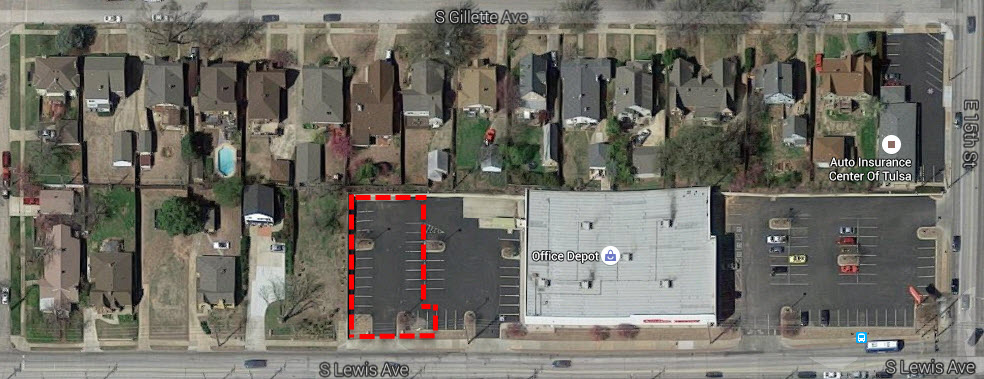
Had the proposed zoning been in place years ago, it could have prevented the demolition of a historic home without impacting the success of the store.
Bad Zoning Costs Money
Why do you care? Because each 7,275 SF lot that was converted to surface parking for this store currently generates about $1,587 in property taxes. Compare this to the remaining homes along Lewis Avenue which generate, on average, $2,626 in property taxes per lot.
By NOT destroying one home for parking that nobody will ever use, Tulsans would have received 65% more in property taxes from that land than they do today.
That’s money that could have been funding public schools, community college, vo-tech, libraries… basically making the city a better place to live.
Or you could have a bunch of asphalt that nobody uses.
Excess parking also adds to the cost of retail space because developers must purchase more land than they actually need. Those costs are folded into the price of commercial leases, which are passed on to you, the consumer. Whether you drive to the store or not, you pay for the “free” parking with every purchase.
It’s Time for a Change
Here’s a better idea. What if we simply eliminated parking minimums from the zoning code? What if we let private land owners determine how many parking spaces were needed for any given development?
This wouldn’t eliminate parking, it would simply give developers the right to decide for themselves how much parking they really need.
(Telling an office supply store how much parking to provide is like telling them how much paper to stock on their shelves. It’s not a job that city planners are qualified to perform.)
Plus, in the age of Amazon Prime and online shopping, excessive parking requirements create a competitive disadvantage for brick and mortar stores. Every parking space adds to the cost of overhead. Meanwhile—in an ironic twist—the need for off-street parking is probably already decreasing due to the increase in online sales.
Without arbitrary parking minimums, the property owner would be incentivized to make the best use of the land. They might determine that 38 parking spaces are more than adequate for their parking needs—especially since the development is directly adjacent to a transit stop in a traditional, walkable neighborhood. (Bonus points if you noticed the bus stopped at the corner of 15th and Lewis in the pictures above.)
A wise developer would encourage transit use, cycling and walking because conserving land—wasting less land on unnecessary parking—means lower costs and/or more space available for buildings that actually generate income.
Small Changes Make a Big Difference
So, what’s an easy way to encourage walking, biking and transit for little or no cost? It’s pretty simple, really.
Bring the front of the building up to the street, making it convenient and safe for pedestrians to access the front door from the sidewalk. Plant trees along the sidewalk to make walking more pleasant and dignified. Create some window displays for people to look at as they walk by. Suddenly, you’re sending a new message: “This is a place for people!”
What would that look like? Just imagine…
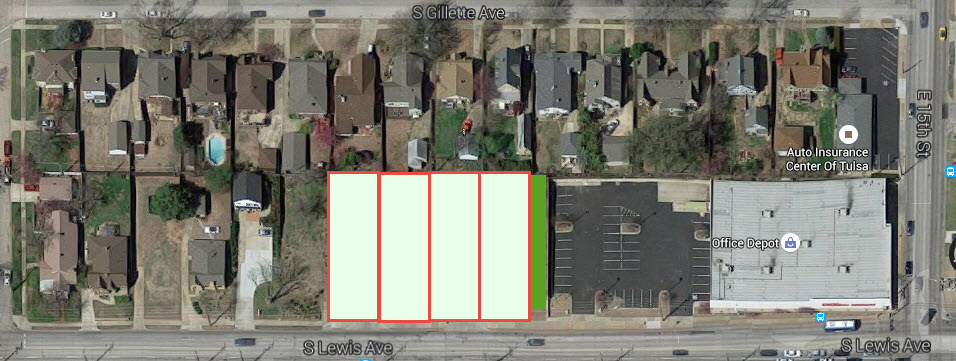
By eliminating parking minimums and bringing the building up to the corner where it belongs, we just preserved FOUR historic homes (increasing the tax base by 65% on each lot), while maintaining an ample supply of off-street parking for the store. There’s even space for a generous landscaping buffer between the parking lot and the residential uses. We’ve also increased the visibility of the commercial building by locating it at the corner of a busy intersection.
All of this can be achieved while making the city a better place for people.
It can be done through zoning.
Which maybe isn’t so boring after all.
Read MoreAmerica’s Love Affair with Our …Dishwashers?
“Americans love their cars!” We hear it so often, we don’t even pause to think how false that statement is.
I own a car. I also own a refrigerator. And a lawn mower. I appreciate all three for what they’re worth. But love? Not so much.
(Funny that no one ever talks about “American’s love affair with their dishwashers.” Substitute any other appliance and it starts to sound kinky. Try it at a party; then watch as people suddenly take a keen interest in the guacamole tray on the other side of the room.)
We don’t love our cars; we love convenience and independence. We love the freedom to move when and where we please. And we want to get there quickly and efficiently. This is an important distinction.
We don’t drive because we love our cars, we drive because—for the past 60 years or so–an entrenched system of financial incentives and public policy has ensured our dependence on the automobile.
First, cities adopted zoning codes that “separated uses.” This means that–for the first time–residential and commercial spaces could no longer co-exist. Modern zoning prevented people from living above a store, and walking across the street to work. Next, because everyone had to drive to every destination, we began prioritizing parking lots over people. Finally, lenders encouraged suburban “greenfield” development, making it easier to build sprawl than to reinvest in older areas of the city.
The result? We have created cities that are so spread out, we must travel great distances to fulfill our most basic needs. Whether we love or hate our cars, most of us need one just to get through the day.
Meanwhile, generations of inadequate funding have left our transit system operating on scraps. While we have invested billions in extending, widening and repaving streets for cars, we have failed to make comparable investments for transit, walking and biking.
So we shouldn’t be surprised when our underfunded transit system fails to deliver fast and efficient service. Imagine what our streets would look like if we hadn’t continually invested in them for the past 70 years!
It’s time for a change.
It’s time we stopped equating America, freedom and independence with the automobile. (It’s a tired old trope that fails to consider the very real burden that cars place on individuals, communities and the environment.) It’s time we started an honest conversation about transportation and the needs of people. And it’s time we started designing our cities, streets and neighborhoods for people, not parking. Only then can we make transit, walking and biking into viable options that will reduce auto-dependency moving forward.
The next time you hear someone talking about how much Americans love their automobiles, you can be ready with a retort: “America should be a place for people, not a place for people to park their cars.”
– Sarah Kobos
Read MorePriorities
Give this a try. Ask someone what’s most important in life. Then listen to their response.
Most likely, they will talk about the people they love. They will mention their spouses, their kids, their parents, their friends and their neighbors. Many will focus on their role as providers or caretakers. They may talk about their jobs, their faith, or their health. Or, you’ll learn about their passion for art, or gardening, or the local sports team. Others will talk about community: their favorite charities, the problems they want to solve, or the people who have made a difference in their lives.
You can quickly see a trend. Our priorities tend to center around family, community, connection, health, purpose, and joy.
With that thought in mind, take a fresh look at the city you call home.
Unless you’re lucky enough to live in a historic neighborhood or a traditional downtown, you’ll quickly see a disconnect between our values and the way we build our cities and towns.
That’s because–for the past 60 years or so–we have failed to design our environment for the people we love. We have failed to prioritize family, community, connection, health, purpose and joy. Instead, we have focused almost entirely on the movement and storage of cars.
Don’t believe me? Look around. What are the defining characteristics of the city you call home?
Wide streets, giant parking lots, enormous signs, and huge buildings dominate the typical suburban landscape. They dwarf us.
Future archaeologists will scratch their heads in wonder, puzzling over what strange species called this place home. The greatest scientific minds will excavate our cities and determine that the average human was 17 feet long, 6 feet wide, 5 feet tall, and traveled at speeds between 45 and 80 MPH. They will conjecture about the strange religious customs that required us to segregate our activities–preventing us from working or shopping in the vicinity where we lived or raised our young. They will marvel at our ability to construct concrete edifices, but wonder about the geo-political threats that must have caused us to disperse so widely across our territory.
What else could explain this ridiculous thing we’ve created?
We have dedicated millions of acres of land to asphalt. In doing so, we’ve created places where it’s not safe, much less desirable, to walk. Instead of bringing people together, we have created barriers. Sadly, we have created places where you need a car to cross the street.
We seem to care more about cars than ourselves. We have robbed ourselves of the pleasure of physical activity. (Would you rather drive to the gym, or walk to dinner?) Meanwhile, we have engineered an epidemic of obesity and chronic disease by making it impossible to get from place to place on foot.
In doing so, we have robbed our children and our elders of their ability to live independently. Instead of enjoying a purposeful, connected life, those who can’t drive become prisoners in their own homes. Unable to work, socialize or shop without driving, many become isolated and disengaged from their communities.
Meanwhile, the ever-increasing cost of maintaining roads and providing police and fire services to far-flung areas depletes municipal budgets. The parks budget is inevitably the first thing cut. Again, we provide for automotive travel, but not safe, enriching places where our children can run and play and make new friends.
We have systematically engineered the least efficient, least sustainable, least logical, and most expensive transportation system imaginable—and then designed our homes, businesses, schools, churches and parks to support that design.
We’ve made a mistake.
It’s time we started thinking about this. It’s time we started asking questions and demanding more.
We can fix it, but it won’t easy to overcome the powerful inertia of the status quo. It’s going to take knowledge and passion and dedication. It’s going to take a lot of people engaging in the process of shaping their communities.
It’s taken us 60 years to get to this point, so transformation won’t happen overnight. But we’ve got to start somewhere. So why not here? Why not now?
It’s time.
Read More